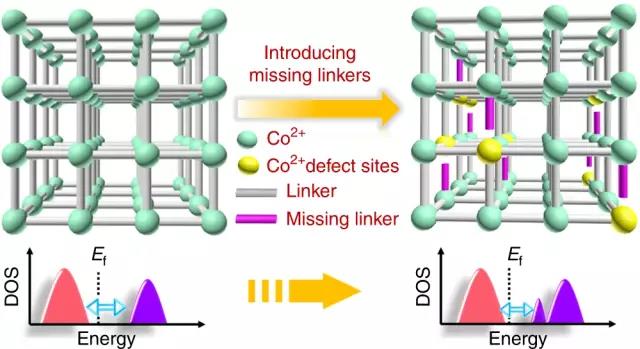Recently, the research team of Professor Liu Min from CSU, jointly with the research team Professor Li Guangqin from Sun Yat-Sen University, published a research paper titled “Missing-linker metal-organic frameworks for oxygen evolution reaction” inNature Communications, a journal of Nature. Doctor Liu Kang from the School of Physics and Electronics of CSU is the first author, and Professor Liu Min and Professor Li Guangqin are thejoint-corresponding authors.

(Modulation of catalytic activity of MOFs via introducing missing linkers)
Metal-organic frameworks (MOFs) have been found a wide utilization because of their structural diversity and functional tunability. As most of MOFs have poor electric conductivity and electro-catalytic property, direct use of MOFs as a high-efficiency catalyst is still at the stage of preliminary research.It has found, through research, that the electro-catalytic property can be greatly improved byincorporating one-way missing linkers into MOFs. Theoretical calculations suggestcarboxyferrocene can regulate the electronic structure of MOFs effectively, thus improving the electric conductivity of MOFs. As a result, the MOFs can enhance the adsorption of OH*, an intermediate of oxygen evolution reaction (OER), and reduce theactivation energy of OH* to O*, which is its OER rate-determining step (1.85eV). Transmission electron microscope andsynchrotron X-ray measurements have confirmed that the missing linkers in the MOFs can be introduced and well controlled by this approach. The MOF nanoarrays with missing linkers obtained in the research exhibit excellent OER performance withultralow overpotential of 241 mV at 100 mA cm−2. This work opens a new prospect to develop efficient MOF-based electrocatalysts by introducing missing linkers.
This is another progress made by the team of Professor Liu Min in these two years after the previous publications in international famous journals such as Nature Photonics, Nature Chemistry, Nature Energy, Joule, Materials Today, Energy & Environmental Science, and Advanced Materials.
Source: School of Physics and Electronics











